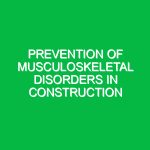Modular and prefabricated construction methods have gained popularity for their efficiency and cost-effectiveness. However, ensuring safety within these frameworks is paramount. Safety in modular and prefabricated construction refers to the practices, regulations, and precautions taken to minimize risks associated with the construction process. This article delves into the various aspects of safety in this domain while emphasizing its significance in the Health, Safety, and Environment (HSE) sector.
The Importance of Safety in Modular and Prefabricated Construction
The construction industry has historically faced numerous safety challenges. Modular and prefabricated construction methods aim to mitigate some of these issues by allowing components to be built off-site in controlled environments. However, this does not eliminate the need for robust safety measures. The relevance of safety in modular construction extends beyond legal compliance; it protects workers, enhances project efficiency, and ultimately contributes to the project’s success.
Understanding Hazards and Risks in Modular and Prefabricated Construction
Safety in modular and prefabricated construction involves identifying various hazards and risks. Understanding these risks is the first step toward implementing effective safety measures. Below are some common hazards associated with this construction method:
Physical Hazards
Physical hazards often arise from the construction environment. These include:
1. Falls from Heights: Workers may need to operate at elevated heights during assembly or installation. Lack of proper fall protection can lead to serious injuries.
2. Equipment Handling: The use of heavy machinery and tools poses risks. Improper handling can result in accidents or injuries.
3. Site Conditions: Poorly maintained site conditions, such as uneven surfaces or clutter, can lead to slips, trips, and falls.
Health Hazards
Health hazards can affect workers over time. Common health risks include:
1. Exposure to Harmful Materials: Some materials used in prefabrication can release toxic substances. Workers should be aware of the materials they handle.
2. Noise and Vibration: Extended exposure to loud noises and vibrations can lead to long-term health issues.
3. Ergonomic Risks: Repetitive motions and awkward postures during assembly can result in musculoskeletal disorders.
Environmental Hazards
Environmental hazards must also be considered. Key points include:
1. Waste Management: Improper disposal of construction waste can lead to environmental contamination.
2. Sustainability Practices: The lack of sustainable practices can contribute to environmental degradation.
3. Weather Conditions: Severe weather can pose risks during both off-site and on-site construction activities.
Best Practices and Safety Precautions
Implementing best practices is essential for minimizing risks in modular and prefabricated construction. Here are actionable safety precautions:
Develop a Comprehensive Safety Plan
A well-thought-out safety plan should include:
– Risk Assessment: Conduct thorough risk assessments to identify potential hazards.
– Training Programs: Provide regular safety training for all workers.
– Emergency Procedures: Establish clear emergency procedures and ensure all workers are familiar with them.
Implement Safety Protocols
Establishing safety protocols is crucial for preventing accidents. Consider the following:
– Use Personal Protective Equipment (PPE): Ensure all workers wear appropriate PPE, including helmets, gloves, and safety glasses.
– Conduct Regular Inspections: Perform regular site inspections to identify hazards and ensure compliance with safety regulations.
– Maintain Equipment: Regular maintenance of machinery and tools is vital to prevent malfunctions and accidents.
Enhance Communication
Effective communication can greatly improve safety. Here’s how:
– Daily Briefings: Hold daily safety briefings to discuss potential hazards and safety measures.
– Clear Signage: Use clear and visible signage to indicate hazardous areas and safety protocols.
– Encourage Reporting: Create an environment where workers feel comfortable reporting hazards without fear of repercussions.
Regulations and Standards Governing Safety in Modular and Prefabricated Construction
Compliance with regulations and standards is critical for ensuring safety in modular and prefabricated construction. Various organizations and guidelines govern safety practices in this field:
Occupational Safety and Health Administration (OSHA)
OSHA sets standards that apply to all construction activities, including modular and prefabricated methods. Key regulations include:
– Fall Protection: OSHA mandates fall protection measures for workers operating at heights.
– Hazard Communication: Employers must inform workers about hazardous materials they may encounter.
National Fire Protection Association (NFPA)
The NFPA provides codes and standards that address fire safety in construction. Important guidelines include:
– Building Codes: Ensure modular units comply with local building codes regarding fire safety.
– Emergency Exits: Design modular units with clearly marked emergency exits.
American National Standards Institute (ANSI)
ANSI develops safety standards that can be applied to modular construction. Key areas include:
– Ergonomic Standards: ANSI provides guidelines for ergonomic practices to prevent injuries.
– Equipment Safety: Standards for the safe use of equipment and machinery on construction sites.
Conclusion
Safety in modular and prefabricated construction is a multifaceted issue that requires attention to detail and a commitment to best practices. By understanding the potential hazards and implementing effective safety measures, stakeholders can foster a safer construction environment. Compliance with relevant regulations enhances overall safety and contributes to the sustainability of the construction industry. As modular and prefabricated methods continue to evolve, prioritizing safety will remain a key factor in their successful implementation.


